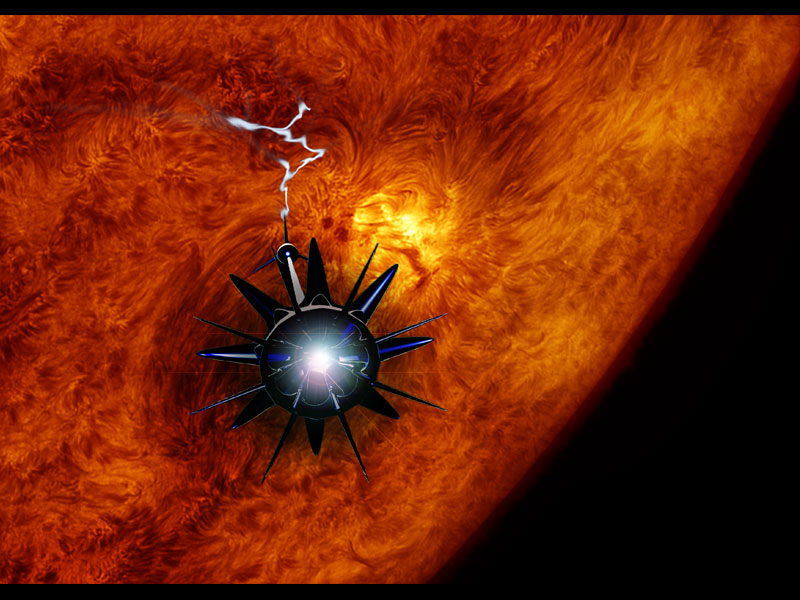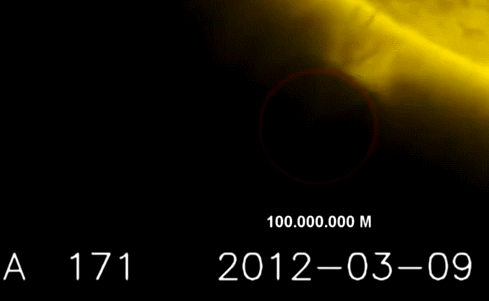It looks like you're using an Ad Blocker.
Please white-list or disable AboveTopSecret.com in your ad-blocking tool.
Thank you.
Some features of ATS will be disabled while you continue to use an ad-blocker.
share:
Well if it isn't a regular satellite I can't only say this., Then it has to be the alien spaceport that surrounds our sun so that spacecrafts from
other systems going in and out just saying , but I might be totally wrong ...


Guys its just Comet ISON. AKA "Scrodingers comet". Itd take me a while to explain why its called that. Its about quantum mecahnics though
yourignoranceisbliss
reply to post by skyblueworld
I'm afraid "Deny Ignorance" has become "Stick your head in the sand".
Here's a close-up view of OP's picture.
Now let's wait for the very same serial debunkers to repeat themselves and ad hominem until they're blue in the face.
This deserves a explanation, a bouble leaving the sun? anybody have exampels of this from earlier?
reply to post by Curious69
people.hao.ucar.edu...
people.hao.ucar.edu...
phys.org...
This deserves a explanation, a bouble leaving the sun? anybody have exampels of this from earlier?
people.hao.ucar.edu...
people.hao.ucar.edu...
phys.org...
edit on 12/4/2013 by Phage because: (no reason given)
Phage
reply to post by Curious69
This deserves a explanation, a bouble leaving the sun? anybody have exampels of this from earlier?
people.hao.ucar.edu...
people.hao.ucar.edu...
phys.org...edit on 12/4/2013 by Phage because: (no reason given)
I agree on what that is. But contrary to the text that yourignoranceisbliss originally posted with that graphic, it doesn't appear to be "a close-up view of OP's picture" at all. It's dated about 21 months previous to the OP's actual GIF, and appears to be a timelapse taken over several days, not 36 milliseconds.
Phage, I would be very interested to hear what you think was in the OP's original graphic. The one about which Richard Schmidt of Burleith Observatory said: "While imaging sunspots we observed a fast-moving satellite with a long boom arm crossing the field of view. This sequence spans 36 milliseconds of real time. The object was moving East at 1 degree per second. Lunt LS100 solar telescope."
This one:
skyblueworld
Taken by Richard Schmidt on December 1, 2013 @ Burleith Observatory, Washington, DC.
Details:
While imaging sunspots we observed a fast-moving satellite with a long boom arm crossing the field of view. This sequence spans 36 milliseconds of real time. The object was moving East at 1 degree per second. Lunt LS100 solar telescope.
Link to source on spaceweather.com
It looks like a weather balloon with a tethered instrument pack or a satellite with a boom, but at 1 degree per second I think it would be moving too fast for either of those.
reply to post by ikonoklast
Let's start by guessing that the object is a satellite and it's in an orbit 250 miles above the Earth. That gives it a speed of 17,157 mph (4.76 mi/sec). At that altitude 4.76 miles has an angular length of 1.09º when directly overhead. For an angular velocity of 1.09º/sec.
Now, we don't know the elevation of the Sun at the time (or do we?) and that "1º/sec" is a suspiciously round number but the lower the orbit, the faster and there are satellites which orbit lower than that so, a satellite is entirely plausible and is the likely culprit and prime suspect.
Since most satellites move east (more or less) the direction isn't a problem.
This sequence spans 36 milliseconds of real time. The object was moving East at 1 degree per second. Lunt LS100 solar telescope."
Let's start by guessing that the object is a satellite and it's in an orbit 250 miles above the Earth. That gives it a speed of 17,157 mph (4.76 mi/sec). At that altitude 4.76 miles has an angular length of 1.09º when directly overhead. For an angular velocity of 1.09º/sec.
Now, we don't know the elevation of the Sun at the time (or do we?) and that "1º/sec" is a suspiciously round number but the lower the orbit, the faster and there are satellites which orbit lower than that so, a satellite is entirely plausible and is the likely culprit and prime suspect.
edit on 12/4/2013 by Phage because: (no reason given)
Phage
reply to post by ikonoklast
Since most satellites move east (more or less) the direction isn't a problem.
This sequence spans 36 milliseconds of real time. The object was moving East at 1 degree per second. Lunt LS100 solar telescope."
Let's start by guessing that the object is a satellite and it's in an orbit 250 miles above the Earth. That gives it a speed of 17,157 mph (4.76 mi/sec). At that altitude 4.76 miles has an angular length of 1.09º when directly overhead. For an angular velocity of 1.09º/sec.
Now, we don't know the elevation of the Sun at the time (or do we?) and that "1º/sec" is a suspiciously round number but the lower the orbit, the faster and there are satellites which orbit lower than that so, a satellite is entirely plausible and is the likely culprit and prime suspect.
edit on 12/4/2013 by Phage because: (no reason given)
The speed, at that altitude, would be 14x that...if its transverse speed was 1 deg a sec.
reply to post by ChuckNasty
Would you care to show your work?
You can start here. A simple way to calculate angular dimensions.
Calculate angle by using a distance of 250 (miles away) and a "size" of 4.76 (miles per second).
www.1728.org...
Or you could do it manually and use the tangent of 1º. Either way will be fine.
Would you care to show your work?
You can start here. A simple way to calculate angular dimensions.
Calculate angle by using a distance of 250 (miles away) and a "size" of 4.76 (miles per second).
www.1728.org...
Or you could do it manually and use the tangent of 1º. Either way will be fine.
edit on 12/4/2013 by Phage because: (no reason given)
Phage
reply to post by ChuckNasty
Would you care to show your work?
You can start here. A simple way to calculate angular dimensions.
Calculate angle by using a distance of 250 (miles away) and a size of 4.76 (miles per second).
www.1728.org...edit on 12/4/2013 by Phage because: (no reason given)
Not my work, but my daughters.. Gave her the numbers and she spat out the speed....now she's updating her FB about how dumb old people are..grandparents will like that one. Oh dear.
Astronomical terms, 1 deg is with the center of the planet being the center and not the observers altitude.
250 miles above the creates a bigger circumference - so that 1 deg in one sec is about 71.279 miles a second.
I could be wrong...
reply to post by ChuckNasty
But I'm old. What do I know?
No. It's the observed angular velocity...how fast it was moving across the sky. Astronomers do not make observations from the center of the planet.
Astronomical terms, 1 deg is with the center of the planet being the center and not the observers altitude.
But I'm old. What do I know?
edit on 12/4/2013 by Phage because: (no reason given)
Phage
reply to post by ChuckNasty
No. It's the observed angular velocity...how fast it was moving across the sky. Astronomers do not make observations from the center of the planet.
Astronomical terms, 1 deg is with the center of the planet being the center and not the observers altitude.
But I'm old. What do I know?
edit on 12/4/2013 by Phage because: (no reason given)
A few post back I wondered the same. With that being true, it makes hella more sense.
With his gear, highly doubt he even had a 1 degree view zoomed in at the sun.
Edit - was thinking the sky being an extension of that latitude and longitude stuff. My bad, zero clue about satellites and astronomy. I need to get a book or two.
edit on 4-12-2013 by ChuckNasty because: as above
edit on 4-12-2013 by ChuckNasty because: autocorrect
error
reply to post by ChuckNasty
The Sun is about 0.5º across.
But by knowing the tracking rate and direction of the telescope and analyzing the pics it wouldn't be too difficult to come up with an accurate angular velocity. That's how they figure out where comets are going, after all, but with a lot more than just "1º/sec east".
I'm just suspicious of such round numbers. 1 is too round for comfort but close enough that it's nothing really unusual.
The Sun is about 0.5º across.
But by knowing the tracking rate and direction of the telescope and analyzing the pics it wouldn't be too difficult to come up with an accurate angular velocity. That's how they figure out where comets are going, after all, but with a lot more than just "1º/sec east".
I'm just suspicious of such round numbers. 1 is too round for comfort but close enough that it's nothing really unusual.
edit on 12/4/2013 by Phage because: (no reason given)
Phage
reply to post by ChuckNasty
The Sun is about 0.5º across.
But by knowing the tracking rate and direction of the telescope and analyzing the pics it wouldn't be too difficult to come up with an accurate angular velocity. That's how they figure out where comets are going, after all, but with a lot more than just "1º/sec east".
I'm just suspicious of such round numbers. 1 is too round for comfort but close enough that it's nothing really unusual.
edit on 12/4/2013 by Phage because: (no reason given)
So what's your take on it being a balloon? The gif looked to be the spots in 1909 region. If the image is turned to reflect the suns north and south, it does look like a balloon dangling its package.
reply to post by ChuckNasty
At 75,000 feet that comes to 892 mph.
At 20,000 feet: 238 mph.
At 5,000 feet: 59 mph
So at 5k the speed starts to get feasible but....
A normal weather balloon will burst at about 35ft in diameter (at around 100,000 ft). At 5,000 feet that would be 0.4º, nearly the diameter of the Sun. So, a small balloon, at low altitude...perhaps.
At 75,000 feet that comes to 892 mph.
At 20,000 feet: 238 mph.
At 5,000 feet: 59 mph
So at 5k the speed starts to get feasible but....
A normal weather balloon will burst at about 35ft in diameter (at around 100,000 ft). At 5,000 feet that would be 0.4º, nearly the diameter of the Sun. So, a small balloon, at low altitude...perhaps.
reply to post by Phage
Sorry but that doesn't quite looks to same of what I'm seeing from the Gif image . I understand that there has to be a logical and natural explanation for it . But it's so perfect round it has to be something else I think ?
In how many occasions did the SDO captured this kind of anomaly? It's pretty rare if you ask me..
Sorry but that doesn't quite looks to same of what I'm seeing from the Gif image . I understand that there has to be a logical and natural explanation for it . But it's so perfect round it has to be something else I think ?
In how many occasions did the SDO captured this kind of anomaly? It's pretty rare if you ask me..
reply to post by skyblueworld
ITT: People learn about perspective and distance.
lol seriously, it's an old nuclear space craft.
ITT: People learn about perspective and distance.
lol seriously, it's an old nuclear space craft.
edit on 5-12-2013 by Gorman91 because: (no reason given)
Phage
At 75,000 feet that comes to 892 mph.
At 20,000 feet: 238 mph.
At 5,000 feet: 59 mph
As mentioned earlier, I did my own calculation of the speed based on an image of the sun on that day and used the sunspot group as a reference for the movement of the object.
I got 0.476 degrees/second.
So the speed figures you have are really only half...
At 75,000 feet that comes to 425 mph.
At 20,000 feet: 113 mph.
At 5,000 feet: 28 mph
I'd like it if somebody could check my work.
alfa1
Phage
At 75,000 feet that comes to 892 mph.
At 20,000 feet: 238 mph.
At 5,000 feet: 59 mph
As mentioned earlier, I did my own calculation of the speed based on an image of the sun on that day and used the sunspot group as a reference for the movement of the object.
I got 0.476 degrees/second.
So the speed figures you have are really only half...
At 75,000 feet that comes to 425 mph.
At 20,000 feet: 113 mph.
At 5,000 feet: 28 mph
I'd like it if somebody could check my work.
Unless I've misunderstood, it looks like this may be a problem
Taking an approximation of half a degree for the sun
Wouldn't that be affected by having less than the full Sun in the FOV?
new topics
-
Boy Scouts to be renamed next year
Other Current Events: 3 hours ago -
Pfizer agrees to settle over 10,000 Zantac lawsuits after cancer causing substance found in drug
Medical Issues & Conspiracies: 3 hours ago -
Judas Iscariot Slips The Hangman's Noose
Political Issues: 6 hours ago -
Murder Suicide Investigation Still Active 4 months later?
Other Current Events: 7 hours ago -
A Shout-out To truthseeker45 Hoot Hoot
General Chit Chat: 8 hours ago -
Ooooh...it worked!!
Members: 11 hours ago
top topics
-
Ooooh...it worked!!
Members: 11 hours ago, 16 flags -
Court of Appeals Agrees to Hear Trump Appeal to Flush Fani Willis
US Political Madness: 17 hours ago, 15 flags -
President Bidens Health is Declining Faster 5.8.2024 - He Should Stay Home.
2024 Elections: 16 hours ago, 9 flags -
Judas Iscariot Slips The Hangman's Noose
Political Issues: 6 hours ago, 9 flags -
New House GOP Bill To Send Pro Hamas College Law Breakers to Gaza for 6 Months
Social Issues and Civil Unrest: 13 hours ago, 9 flags -
A Shout-out To truthseeker45 Hoot Hoot
General Chit Chat: 8 hours ago, 4 flags -
Pfizer agrees to settle over 10,000 Zantac lawsuits after cancer causing substance found in drug
Medical Issues & Conspiracies: 3 hours ago, 3 flags -
Murder Suicide Investigation Still Active 4 months later?
Other Current Events: 7 hours ago, 2 flags -
Pentagon UFO Hunter Reveals What He Knows About Aliens: Nothing
Aliens and UFOs: 15 hours ago, 2 flags -
Boy Scouts to be renamed next year
Other Current Events: 3 hours ago, 1 flags
active topics
-
Pfizer agrees to settle over 10,000 Zantac lawsuits after cancer causing substance found in drug
Medical Issues & Conspiracies • 3 • : Kekrops -
Boy Scouts to be renamed next year
Other Current Events • 2 • : Hecate666 -
Modern Mind Control
General Conspiracies • 58 • : AllisVibration -
New whistleblower Jason Sands speaks on Twitter Spaces last night.
Aliens and UFOs • 126 • : Jukiodone -
Chinese scientists create new mutant Ebola strain with horror eye symptoms
Breaking Alternative News • 34 • : Kurokage -
Liberal Democrats to Table a Motion of No Confidence in the government Tomorrow
Regional Politics • 13 • : gortex -
New House GOP Bill To Send Pro Hamas College Law Breakers to Gaza for 6 Months
Social Issues and Civil Unrest • 85 • : SchrodingersRat -
Judas Iscariot Slips The Hangman's Noose
Political Issues • 20 • : SchrodingersRat -
Ooooh...it worked!!
Members • 11 • : gortex -
Russia Ukraine Update Thread - part 3
World War Three • 5765 • : F2d5thCavv2


